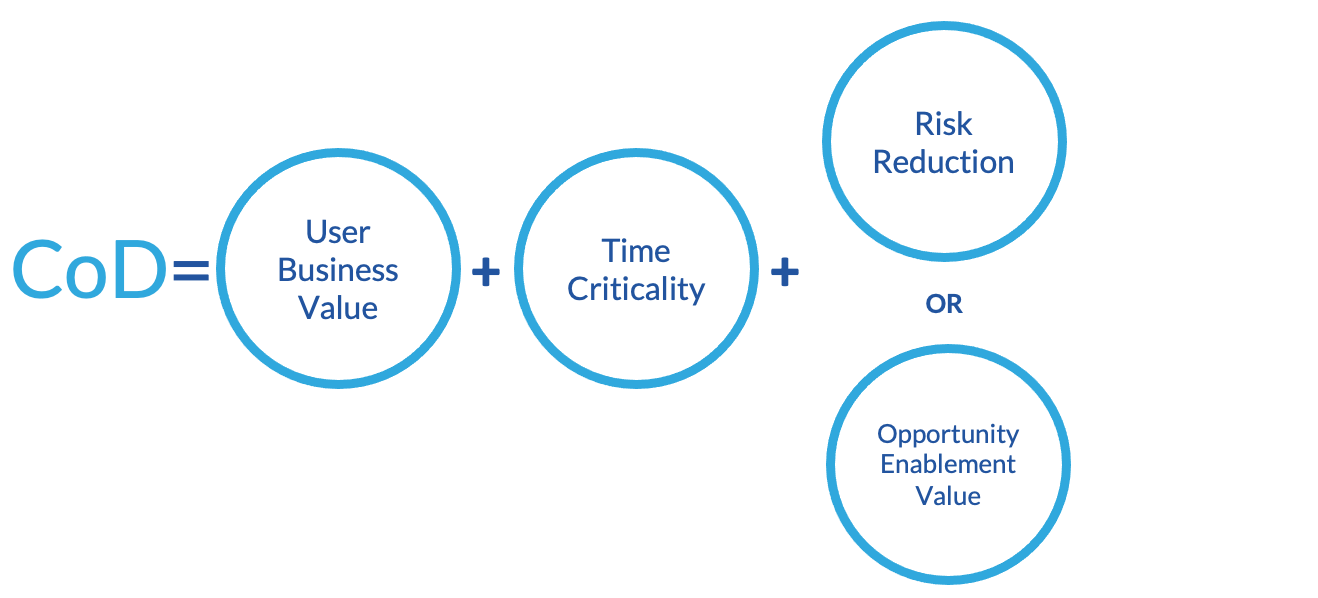Is your team struggling to keep up with the constantly changing requirements and feature requests? Are you getting a few things almost done, but nothing is quite ready to ship? What is your prioritization process like?
At Ascendle, you will hear us saying “if everything is important, nothing is important.” It’s critical for your team and your business to have absolute clarity on the most important objectives. But how do you get there? Ruthless Prioritization.
There are many frameworks to use, including Kano Models and RICE, but this article will focus on Weighted Shortest Job First (WSJF).
Already have a handle on WSJF? Get immediate access to Ascendle’s free WSJF calculator!
What is Weighted Shortest Job First (WSJF)?
Like all prioritization frameworks, WSJF aims to quantify the potential business value to be realized by the addition of a given feature. And similar to most models, WSJF also takes into account the estimated effort to produce said feature. However, WSJF goes one step further by introducing a new component to the equation: the Cost of Delay (CoD).
How to Use a WSFJ Calculator
You calculate WSJF by quantifying user or business value, time criticality, and risk reduction or opportunity enablement and then divided by the perceived effort. In simple terms you’re analyzing how much the user will benefit from the feature, does it need to happen now, will it help the organization grow, and how hard is it to build? Essentially, is the juice worth the squeeze? Let’s look at each component to understand how to get the most accurate data.
Cost of Delay (CoD)
Simply put, CoD recognizes that if a given feature is intended to provide incremental value to a product, by definition, the lack of that feature will have a corresponding negative impact on the business. This CoD impact is made up of three components: user business value, time criticality, and risk reduction:
1. User or Business Value
This is the relative value to the business or customer. Each company that uses WSJF will measure this “value” differently and – like all frameworks – consistency is key. Are you anticipating increasing your user base or engagement within your tool? This question helps quantify user or business value.
2. Time Criticality
Next, you will look at time. WSJF acknowledges the critical role that time can play when predicting business value. In some situations, incremental improvements can be released without regard to the day or month. However, if your release must coincide with a major trade show or a customer request, the time criticality of a project can be substantial. In organizations where time criticality varies greatly, WSJF is often a superior solution compared to other frameworks.
3. Risk Reduction or Opportunity Enablement
Finally, CoD quantifies risk reduction or opportunity enablement. If most of your competitors have a given feature, your organization’s release of a similar feature is a risk reduction; it hasn’t been added to increase business but to retain business. Likewise, features labeled as opportunity enablement indicate the ability to please new customers or existing customers in unique, new ways.
Using Estimation Tools
For each of the components of CoD, you can use the Cohn Scale, a modified Fibonacci sequence, to measure effort. The purpose of the Cohn Scale isn’t to accurately measure anything. Rather, the goal is to be able to quantify one component relative to another one. Said differently, we’re not concerned if one feature is worth ten million dollars in revenue and the other is worth twenty million. Instead, we’re concerned that the user business value of one is two times that of the other.
The above three factors are then used to derive the formula for Cost of Delay.
The WSJF Formula
Once Cost of Delay has been calculated, dividing the result by the estimated effort to produce a given feature results in the WSJF score. Similar to the components of the Cost of Delay, Cohn Scale numbers are also recommended to estimate effort. Again, the concern isn’t to measure the number of hours or days required, only the amount of time required, relative to the other features that are being measured.
Ready to build your own WSJF model? Get our free WSJF calculator!
Benefits of Using the Weighted Shortest Job First (WSJF) Model
WSJF isn’t the only prioritization tool available, but there are quite a few benefits that help it stand out. In addition to quantifying business value that allows for better cross-communication, here are three benefits of using WSJF for prioritizing features or efforts:
1. WSJF Is More Comprehensive
Popular frameworks like Kano Models are fine for understanding the potential appeal of a given feature, and RICE acknowledges that effort needs to be juxtaposed with potential return. But WSJF stands alone for the introduction of time criticality. Indeed, depending on your industry or application, time criticality could be the most important component of all!
2. WSJF Quantifies the Unquantifiable
Software estimation is difficult. Ironically, so is quantifying both the potential appeal and time criticality of a given feature. By using numbers from the Cohn Scale, you ensure that the formula succeeds where it needs to; in assigning relativity to a list of features in a consistent manner.
3. WSJF Empowers Agile Teams
To be clear, it takes a while for your teams to get comfortable with relative estimation. However, once they do, it becomes a valuable piece in their toolkit. For those teams that have more experience, WSJF fits like a glove, enabling them to properly prioritize their product backlogs.
Improving Estimation is Critical for Accurate Prioritization
WSJF is a powerful feature prioritization framework. Now that you’re ready to put our WSJF calculator to use, here are a few things to keep in mind as you attempt to roll it into your organization:
1. Relative estimations are only as good as your relative estimating.
Keep in mind that all four components of the WSJF formula rely on a proper understanding of how to apply relative point totals. Estimation is an art more than a science. If your team is just getting started, check out our “Art of Estimation” webinar!
2. Relative estimations can change over time.
In particular, the user or business value, time criticality, and opportunity enablement components of the formula may shift as the market does. As such, it’s critical to revisit your formulas periodically to make sure they reflect the current state of business.
3. Size Matters
WSJF can inhibit large features from being developed if your teams don’t work to break them down into smaller components. In WSJF, the estimated effort is the denominator. Simply put, a large denominator will suppress scores from breaking through to the top of the backlog. Savvy Product Owners know this and work hard to find ways to chop features up into smaller components.
Is WSJF Right for you?
Teams with small feature lists or those that operate in verticals where competition isn’t a constant threat might consider WSJF to be overly complex for their needs. But for organizations that must consider multiple points of data and swiftly prioritize in a rigorous manner, WSJF serves as a valuable tool to maintain a competitive edge.
Though we’re big fans of many feature prioritization techniques, we favor WSJF for its simplicity and potency.
Download your free copy of the WSJF calculator >
Editor’s Note: This post was updated on April 3, 2023 for accuracy and comprehensiveness.







